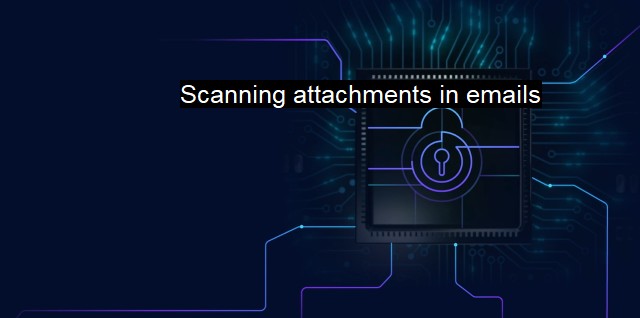What are Scanning attachments in emails?
The Significance of Scanning Email Attachments for Viruses: Why Antivirus Software is Crucial in Today's Technology-Driven World
Scanning attachments in emails is a fundamental procedure in the field of cybersecurity and antivirus protection. In the increasingly digitized world, more individuals and companies rely on emails for communication: sending documents, photos, videos, and other files as attachments. lurking behind the convenience of this, cyber attackers have used email attachments as a popular method to distribute malware, such as viruses, ransomware, spyware, and Trojans.Scanning these attachments before opening them has become essential and helps protect computers or network systems from potential threats. It allows for the detection and prevention of harmful components that may be tagged with the contents being sent or received over email. The process involves the use of antivirus software which deconstructs the received file, analyzes it to identify any potential threats, and ensures that it's safe for the user to download and access.
How does attachment scanning operate? every file that comes with an email undergoes scrutinization by the installed antivirus program. Incoming email attachments are typically isolated in a secure spot dubbed as a sandbox. This is a controlled environment, separate from the main system where potentially hazardous files can be opened or executed without endangering the user's device or network. Once the file is in the sandbox, the antivirus software scrutinizes the contents, checks for known signatures of viruses, and other malware.
The process also includes heuristic evaluation where the content is checked for any suspect behavior that aligns with virus-like characteristics. This extends beyond the realm of already identified threats and deals with potential ones that have not yet been catalogued. Files are also contextualized; for instance, an Excel spreadsheet with executable code might be flagged for further examination. This combination of tactics makes up the comprehensive nature of email attachment scanning.
Immediate advantages are realized from scanning attachments where safety and security become the underlying agenda. Users get insights into which attachments pose a risk, prompting action like quarantine or deletion of those harmful files. Protected systems result in minimal interruptions and operational productivity is high.
Alarmingly, cyber threats have evolved. Determined hackers have developed strategies for bypassing this type of defense, including encryption and polymorphic viruses which continually alter their code to avoid detection. Therefore, standalone email attachment scanning may not provide foolproof security. It should be a part of multi-layered security that includes updated antivirus software, continuous monitoring and analysis of both inbound and outbound traffic, and standing firewall protocols designed to keep all systems safe.
It's also vitally essential to cultivate a keen and smart cyberspace culture where people become an echo of these cyber-defense mechanisms. Users must be cyber-aware and encouraged not to open emails or download attachments from an unknown source, no matter how genuine they may seem. In particular, users should be careful about social engineering tactics like phishing where an attacker may impersonate a trusted organization to lure victims.
Greater investment in more resourceful artificial intelligence cyber-security could offer a stronger solution. AI analyzes behavior, making predictions about which kind of behavior may be harmful. Such predictive analytics leverage machine learning algorithms to detect patterns not discernible by human or traditional cyber-security efforts, which could identify malware that often slips through antivirus software.
Scanning email attachments is a critical process in maintaining a secure digital environment. While it is crucial, remember it's part of a defense-in-depth strategy for comprehensive protection. Doing so can reduce the risk of cyberattacks, maintain the integrity and confidentiality of data, and provide greater assurance and peace of mind to users.

Scanning attachments in emails FAQs
Why is it important to scan email attachments for cybersecurity?
Scanning email attachments for cybersecurity is essential because attachments can carry viruses, malware, and other malicious codes that can compromise the security of your system. Scanning helps detect and remove any suspicious files or content that may be harmful to your computer systems.What antivirus software should I use to scan email attachments?
There are several antivirus software options you can use to scan email attachments, including Avast Antivirus, Norton Security, McAfee, and Kaspersky. It is important to research and choose a reliable software solution that will provide the necessary protection for your cybersecurity.Can scanning email attachments slow down my computer?
Scanning email attachments may slightly affect the performance of your computer, but modern antivirus software is designed to be efficient and to run seamlessly in the background without causing any significant slowdowns. The antivirus scans and detects potential threats without causing any noticeable delays or interruptions.What should I do if a suspicious email attachment is detected?
If your antivirus software detects a suspicious email attachment, it is essential to avoid opening or downloading the file. Delete the email immediately and notify your IT department or cybersecurity team. They can investigate the issue, determine the severity of the threat, and take appropriate actions to prevent further damage.| | A | | | B | | | C | | | D | | | E | | | F | | | G | | | H | | | I | | | J | | | K | | | L | | | M | |
| | N | | | O | | | P | | | Q | | | R | | | S | | | T | | | U | | | V | | | W | | | X | | | Y | | | Z | |
| | 1 | | | 2 | | | 3 | | | 4 | | | 7 | | | 8 | | |||||||